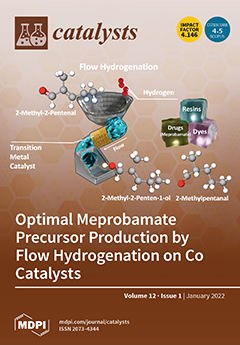Solar photothermo-catalysis is a fascinating multi-catalytic approach for volatile organic compounds (VOCs) removal. In this work, we have explored the performance and the chemico-physical features of non-critical, noble, metal-free MnO
x-ZrO
2 mixed oxides. The structural, morphological, and optical characterizations of these
[...] Read more.
Solar photothermo-catalysis is a fascinating multi-catalytic approach for volatile organic compounds (VOCs) removal. In this work, we have explored the performance and the chemico-physical features of non-critical, noble, metal-free MnO
x-ZrO
2 mixed oxides. The structural, morphological, and optical characterizations of these materials pointed to as a low amount of ZrO
2 favoured a good interaction and the ionic exchange between the Mn and the Zr ions. This favoured the redox properties of MnO
x increasing the mobility of its oxygens that can participate in the VOCs oxidation through a Mars-van Krevelen mechanism. The further application of solar irradiation sped up the oxidation reactions promoting the VOCs total oxidation to CO
2. The MnO
x-5 wt.%ZrO
2 sample showed, in the photothermo-catalytic tests, a toluene T
90 (temperature of 90% of conversion) of 180 °C and an ethanol T
90 conversion to CO
2 of 156 °C, 36 °C, and 205 °C lower compared to the thermocatalytic tests, respectively. Finally, the same sample exhibited 84% toluene conversion and the best selectivity to CO
2 in the ethanol removal after 5 h of solar irradiation at room temperature, a photoactivity similar to the most employed TiO
2-based materials. The as-synthetized mixed oxide is promising for an improved sustainability in both catalyst design and environmental applications.
Full article





